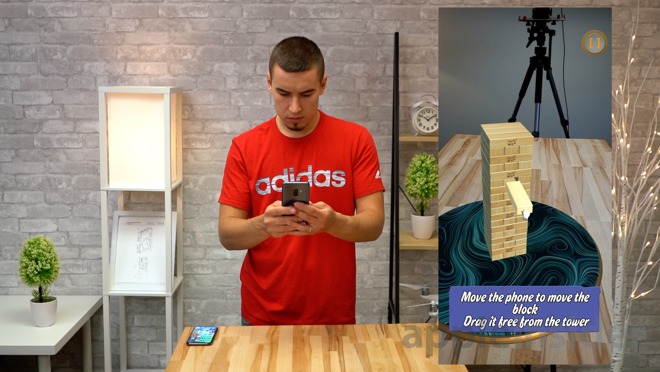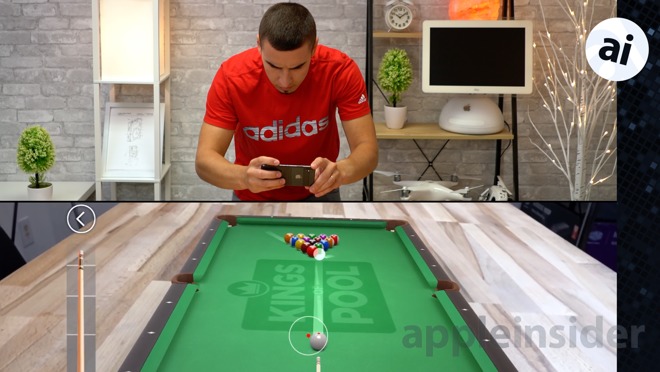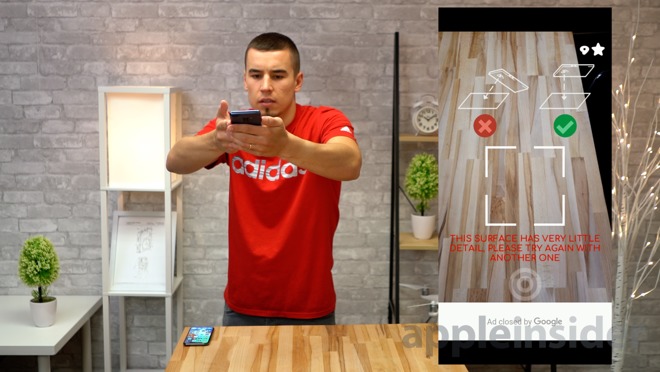Video: iPhone X vs Galaxy S9+ AR Gaming -- ARKit vs ARCore
Apple's ARKit made a public debut at WWDC 2017 and was later released with iOS 11, enabling any iOS device with an A9 or newer processor to run augmented reality games and apps. Like clockwork, Google introduced a competing product in ARCore for devices running Android. We take a closer at the respective AR platforms in this video.
Two more months after Google's announcement of ARCore, Samsung promised hardware compatibility with the framework. Those capabilities have been a long time coming; Samsung's Galaxy S9 and S9 Plus were released in March, but they didn't get ARCore support until the middle of May.
With Samsung's flagship smartphone now able to run ARCore apps, we decided it was time to compare Google's AR system with that of Apple's, as running on iPhone X.
To get a better look at the differences and similarities between the two platforms, we initially planned on comparing a number of AR apps that provide cross-platform support. This would ensure an even playing field and offer a more accurate representation of how developers are handling and integrating each technology, from surface tracking to graphics quality.
Unfortunately, Samsung's Galaxy S9 Plus was in many cases unable to recognize an anchor point (our desk) for AR tracking. Whether the problem is with Samsung's hardware or Google's software is unknown, but for the purposes of this comparison, the shortcoming forced us to look at ARCore-specific apps that worked.

AR Insect Invaders:
On iOS, the iPhone X instantly recognized the surface we selected and accurately tracked it. After placing the plate of sushi, it didn't move at all in respect to the table. Tracking continued to work perfectly and it offered a great gaming experience.
On the S9 Plus, the app recognized the surface, but the graphics seemed to bend while we moved the camera around. After placing the plate, it started to jitter and wobble around. Shortly after that, it completely lost track of where it was placed. The game never regained tracking and was completely unplayable.
IKEA Place:
Again, the iPhone X did a great job of tracking the desk and the objects we placed on it stayed put. We could easily change angles and get close for a detailed look at the furniture.
The S9 Plus took a very long time to recognize the desk, and when it did, the objects failed to appear at all after multiple tries.
Kings of Pool:
The iPhone X handled this game perfectly. There was no gap under the pool table, it looked like it was sitting right on top of the desk. The tracking was amazing, it didn't move an inch from the spot we placed it. The gaming experience was really fun and accurate.
The S9 Plus, on the other hand, couldn't even recognize the surface of the desk.

Thomas & Friends Minis:
This is a great game for kids. You can build tracks and view them in AR. The iPhone X did a great job on this one as well. The best part is that ARKit has spatial sound, so when I would get closer to certain areas of the track, sounds from those areas would get louder.
The S9 Plus again failed to scan the desk.
Stack AR:
Unsurprisingly, the iPhone X scanned and recognized the surface instantly. The game was enjoyable and easy to play.
The S9 plus again failed to scan the desk.
Leo AR Camera:
The S9 Plus was finally able to scan and recognize our desk, but when we placed an object, it drifted away. This happened with every single object we placed.
Jenga AR:
This game is exclusive to the Google Play Store. We actually searched ARCore to find this one. This was the first game that worked as intended. The tracking was perfect, and the lighting was great. Gameplay was very smooth.
ARCoreMeasure:
This app is also exclusive to the Google Play Store, and it worked surprisingly well. The measurements seemed accurate and none of the objects drifted.
Atom Visualizer:
Here's another Android exclusive. This one worked perfectly. It seems like cross-platform games and apps aren't supported at this time. Everything we've tried so far that's exclusive to the Google Play Store works great.

In the cases where the S9 Plus did scan the table, the tracking would fail completely. There were only one or two games that would actually work correctly, but when ARCore did work, it worked great. Tracking, shadows and lighting were on point.
We're not sure why the Samsung had so much trouble with the games and apps we tested. Samsung's system software, ARCore, and each game was up to date. Since the S9 Plus is supposed to support ARCore, and all of these games are available to download on the Google Play Store, there's no reason why the AR experience should be this bad.
Two more months after Google's announcement of ARCore, Samsung promised hardware compatibility with the framework. Those capabilities have been a long time coming; Samsung's Galaxy S9 and S9 Plus were released in March, but they didn't get ARCore support until the middle of May.
With Samsung's flagship smartphone now able to run ARCore apps, we decided it was time to compare Google's AR system with that of Apple's, as running on iPhone X.
To get a better look at the differences and similarities between the two platforms, we initially planned on comparing a number of AR apps that provide cross-platform support. This would ensure an even playing field and offer a more accurate representation of how developers are handling and integrating each technology, from surface tracking to graphics quality.
Unfortunately, Samsung's Galaxy S9 Plus was in many cases unable to recognize an anchor point (our desk) for AR tracking. Whether the problem is with Samsung's hardware or Google's software is unknown, but for the purposes of this comparison, the shortcoming forced us to look at ARCore-specific apps that worked.

AR Insect Invaders:
On iOS, the iPhone X instantly recognized the surface we selected and accurately tracked it. After placing the plate of sushi, it didn't move at all in respect to the table. Tracking continued to work perfectly and it offered a great gaming experience.
On the S9 Plus, the app recognized the surface, but the graphics seemed to bend while we moved the camera around. After placing the plate, it started to jitter and wobble around. Shortly after that, it completely lost track of where it was placed. The game never regained tracking and was completely unplayable.
IKEA Place:
Again, the iPhone X did a great job of tracking the desk and the objects we placed on it stayed put. We could easily change angles and get close for a detailed look at the furniture.
The S9 Plus took a very long time to recognize the desk, and when it did, the objects failed to appear at all after multiple tries.
Kings of Pool:
The iPhone X handled this game perfectly. There was no gap under the pool table, it looked like it was sitting right on top of the desk. The tracking was amazing, it didn't move an inch from the spot we placed it. The gaming experience was really fun and accurate.
The S9 Plus, on the other hand, couldn't even recognize the surface of the desk.

Thomas & Friends Minis:
This is a great game for kids. You can build tracks and view them in AR. The iPhone X did a great job on this one as well. The best part is that ARKit has spatial sound, so when I would get closer to certain areas of the track, sounds from those areas would get louder.
The S9 Plus again failed to scan the desk.
Stack AR:
Unsurprisingly, the iPhone X scanned and recognized the surface instantly. The game was enjoyable and easy to play.
The S9 plus again failed to scan the desk.
Leo AR Camera:
The S9 Plus was finally able to scan and recognize our desk, but when we placed an object, it drifted away. This happened with every single object we placed.
Jenga AR:
This game is exclusive to the Google Play Store. We actually searched ARCore to find this one. This was the first game that worked as intended. The tracking was perfect, and the lighting was great. Gameplay was very smooth.
ARCoreMeasure:
This app is also exclusive to the Google Play Store, and it worked surprisingly well. The measurements seemed accurate and none of the objects drifted.
Atom Visualizer:
Here's another Android exclusive. This one worked perfectly. It seems like cross-platform games and apps aren't supported at this time. Everything we've tried so far that's exclusive to the Google Play Store works great.

Conclusion:
The S9 Plus had trouble with almost every game and app we tested, especially cross-platform titles. In most cases, it wouldn't even scan our large desk. The iPhone X scanned the same surface every single time, almost instantly.In the cases where the S9 Plus did scan the table, the tracking would fail completely. There were only one or two games that would actually work correctly, but when ARCore did work, it worked great. Tracking, shadows and lighting were on point.
We're not sure why the Samsung had so much trouble with the games and apps we tested. Samsung's system software, ARCore, and each game was up to date. Since the S9 Plus is supposed to support ARCore, and all of these games are available to download on the Google Play Store, there's no reason why the AR experience should be this bad.


Comments
but it you weren’t using the S9 correctly. Google and Samsung are far more innovative and capable than Apple. /s
I’d rather make an app that runs as advertised for iOS exclusively than to port it to Android and work like a giant turd.
I've seen some ARCore apps on a Pixel 2 and it worked quite well.
Google in contrast has recently demonstrated more vision and capabilities on how to utilize augmented reality in their ecosystem in a meaningful way.
I hope I’m proven wrong in June and Apple amazes me, but for now they have been caught up on the SaaS side on many levels and they’ll have a hard time catching up.
When introducing amazing new technology Apple should always release it with a killer app to prove it is amazing. Also, work with developers to make sure there are a heap of killer apps in short order. Over and over again Apple just release something cool and then there is no follow up, so it just withers.
The touchbar is another recent example.
3D touch is another thing... it’s been totally gimmicky and they haven’t convinced the end user of any real use for it, other than app icon shortcuts. Removing it makes the interface more simple and production cheaper.
I'm hoping you forgot to type the /s. More RAM is nice, but more efficiency trumps it. If an operating system can do more with less resources, isn't that a great achievement? It's been proven that iOS excels with that. The problem with adding more RAM just to boost spec bravado is that developers are lazy and won't bother to optimize for a small memory footprint, and then we just end up with slow, bloated apps anyway.
Apple has a history of creating features that the full potentials aren't realized for quite some time, as they are working on future devices that take advantage of said features.
i think the issue might be that the iPhone is just the wrong platform for AR. The technology will eventually advance to a point where good AR glasses are feasible. That’s when AR takes off. Apple seems to be using their customers as beta testers for software that will eventually show up in that platform
Yes, we did some direct comparison at work for a customer and my colleague's conclusion was that ARCore actually performed better. But he used iP X and a P2 as well, so this might be a Samsung issue.
In the end the comparison didn't matter as ARCore is cross platform, ARKit is iOS only.
As for AR, I have yet to use a single app on my X that uses it. Seems like a huge waste. If someone were to show me a practical AR app that I would fine useful I'd be all over it, but I'm not going to download a silly pool game just to use it.